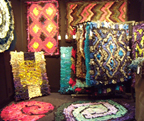Last May, I came home from the Spinrite Tent Sale in Washington, NC, with a car full of colorful yarn, $100+ worth in four large (black plastic trash bag-size) bags. I spent the summer figuring out how to bring a Bond Ultimate Sweater Machine (found at a thrift shop several years ago) online and, when it eventually started working smoothly, bought another one to have a longer bed. Instead, I set up one machine at each end of my commuter marriage, and I’m thinking about buying another machine to get that longer bed.
I learned how to do a plain cardigan in stockinette stitch. When Spinrite announced the dates for the 2020 tent sale, I inventoried the yarn still in stash and thought hard about how to use it up by June so I could (have room to) buy more.
The next project was to use up worsted yarn, bought from the bins of unlabeled yarn at $20/(as many skeins as you could fit into a small plastic bag). In this case, a “small” bag held seven skeins of what is probably Red Heart. The purple and blue skeins in the upper right of the picture below are two of these skeins.
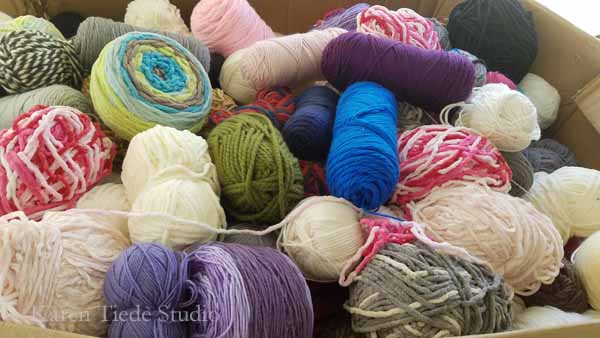
Last night, I started swatching patterns. I had thought I would do something fun in a slip stitch pattern from one of Barbara Walker’s books, but when I tested, I discover the Bond does not like doing two rows of slipped stitches, and that bringing a slipped stitch back into production requires manually lifting the stitch out of hold position over the latch. This was not what I bought inexpensive yarn for. At that rate, hand knitting would work as well.
I could do a Fair Isle pattern, but those take twice as much yarn per row, and I didn’t need the extra warmth provided by two strands of yarn. I looked through my books. In Hand-Manipulated Stitches for Machine Knitters, I saw a three-color stripe formed by lifting stitches and then changing colors. Lifted stitches caused the stripe to curve, and yet the knitting was straight across for most of the rows. That looked interesting, manageable, and quick. In the swatch below, the blue is from the afghan yarn, and the pink and green are yarns from stash that are a similar weight.
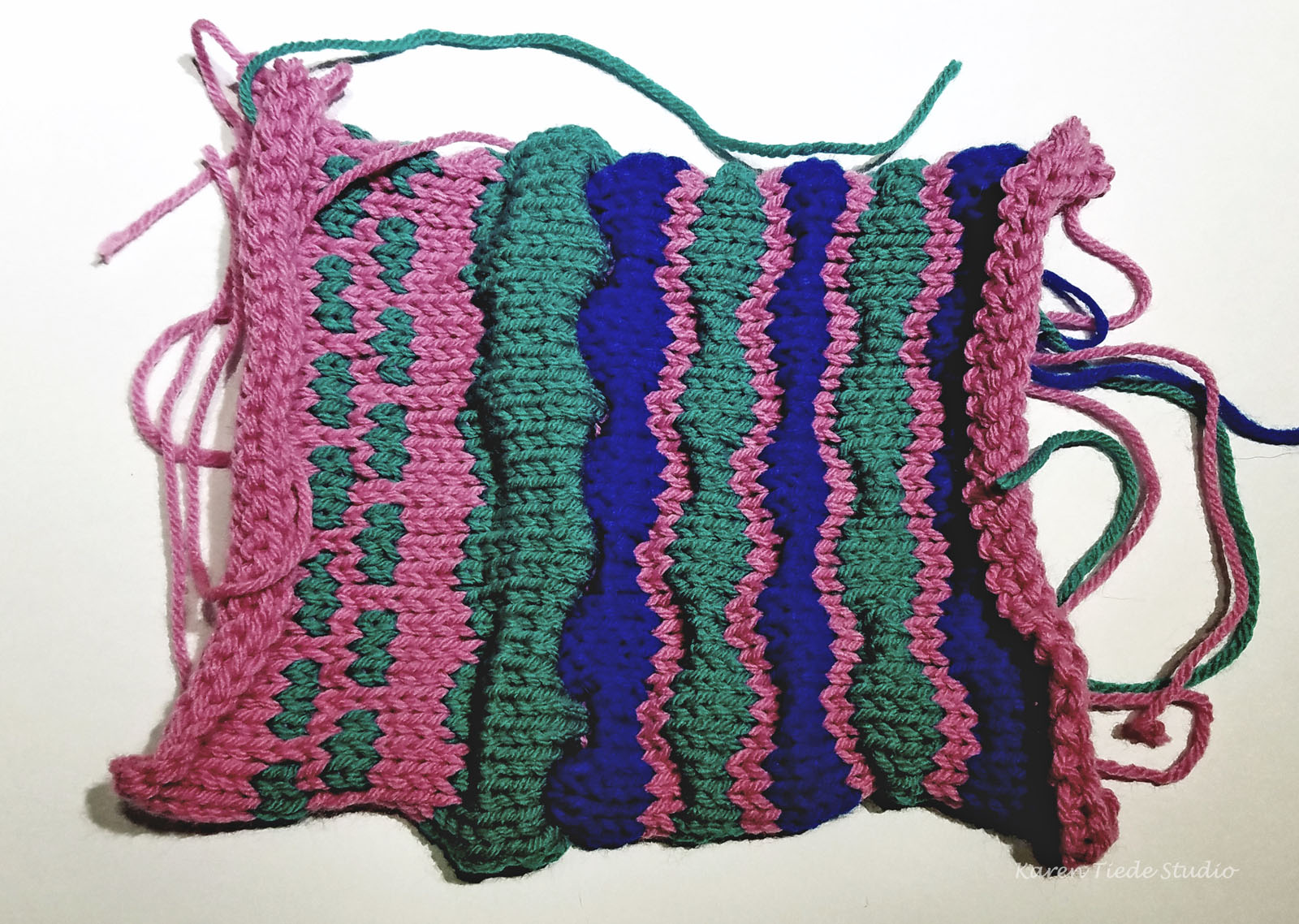
I swatched some more. The charted instructions said to lift across 8 rows, but the swatch looked nothing like the picture and put too much texture in the row. I tried six rows, then four, then discovered that I needed to lift from the second row, not the first, so that I wasn’t lifting on the diagonal, which would eventually put some bias twist into the fabric. In the afghan shown, two stitches are lifted from the second onto the fifth row, and then a sixth row of the same color is knitted across to catch the lift.
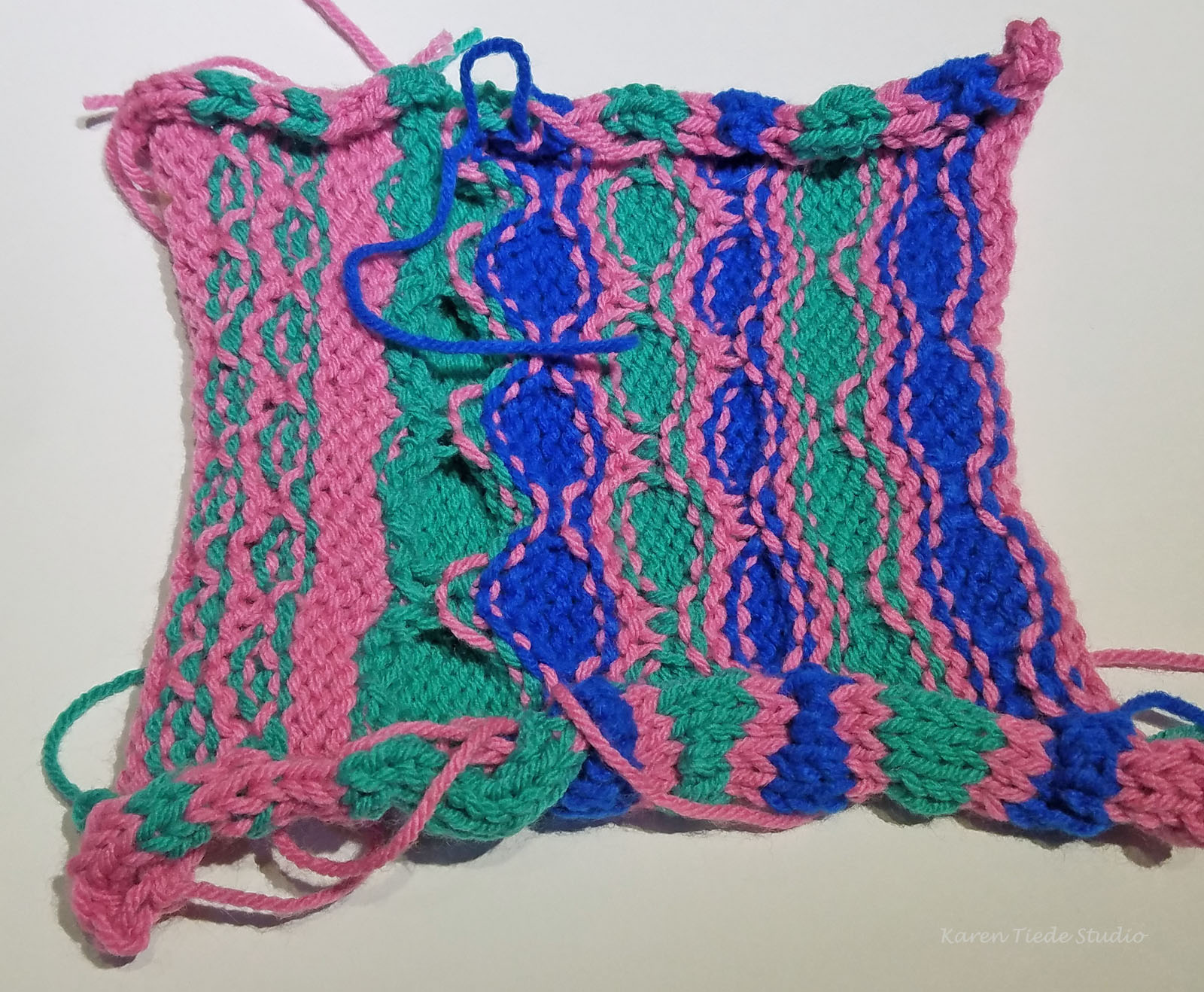
A closer view of the lift:
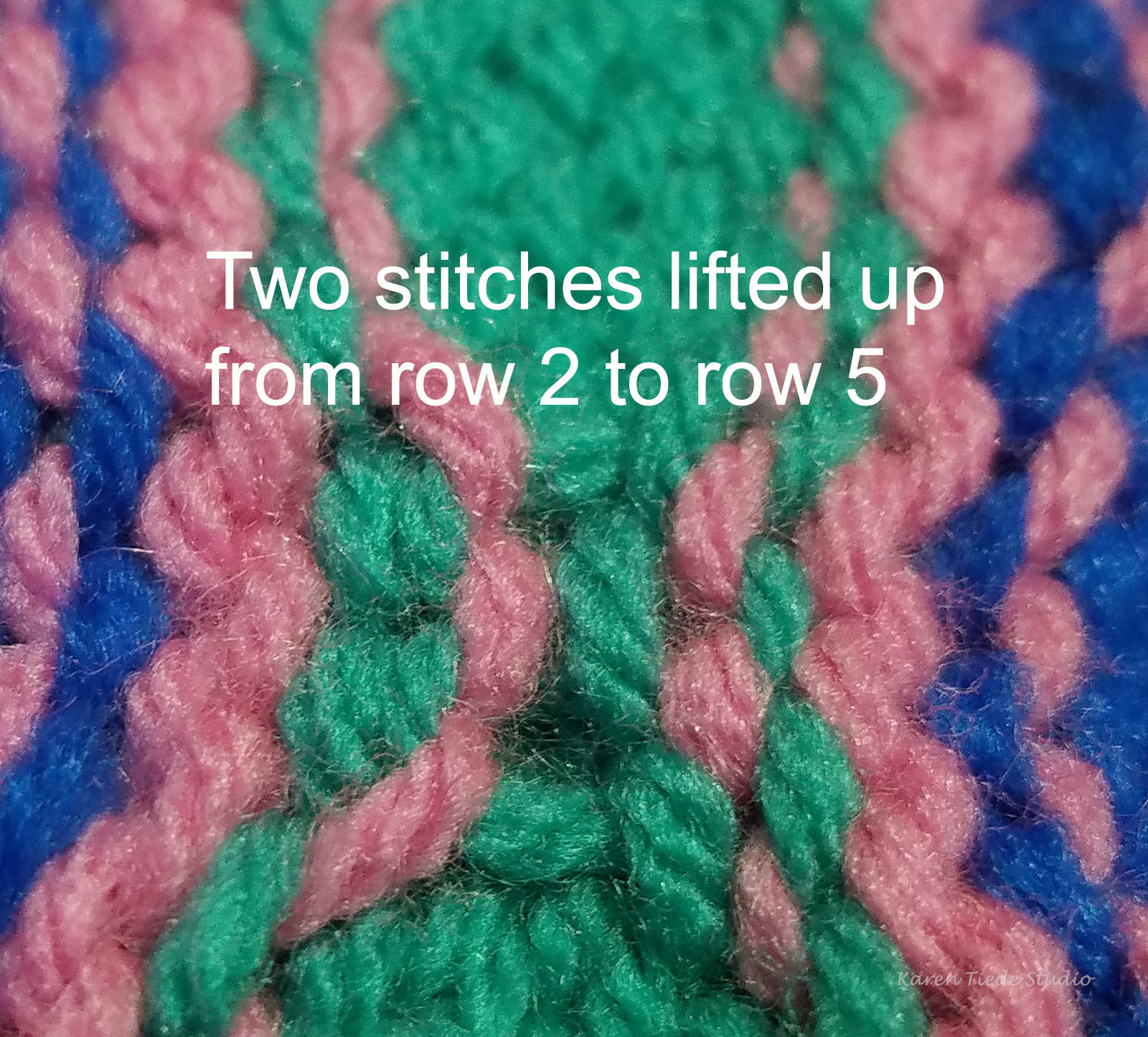
As I tested, I was also thinking about how to change colors so that I would use up all the yarn I bought at about the same time, but I didn’t worry about it too much in the test.
Eventually, I cast on a strip of XYZ stitches, which is nearly the full width of the Bond, and knit 10 rows in purple. I stopped and reformed these into a 1×4 rib to reduce the curl at the top and bottom. (I might have to do something else when the strip comes off the machine, but at least some ribbing will uncurl the cast-on and -off edges.)
Then I knit two rows of straight purple, five of blue, lifted stitches from Row 2 to Row 5, and knit another row of blue, followed by four of purple. About 10 stitches jumped off the needles on the last row, and it was late, so I stabilized the stitches and left the work for the night.
This morning, I sat with the swatch to do the math on changing colors.
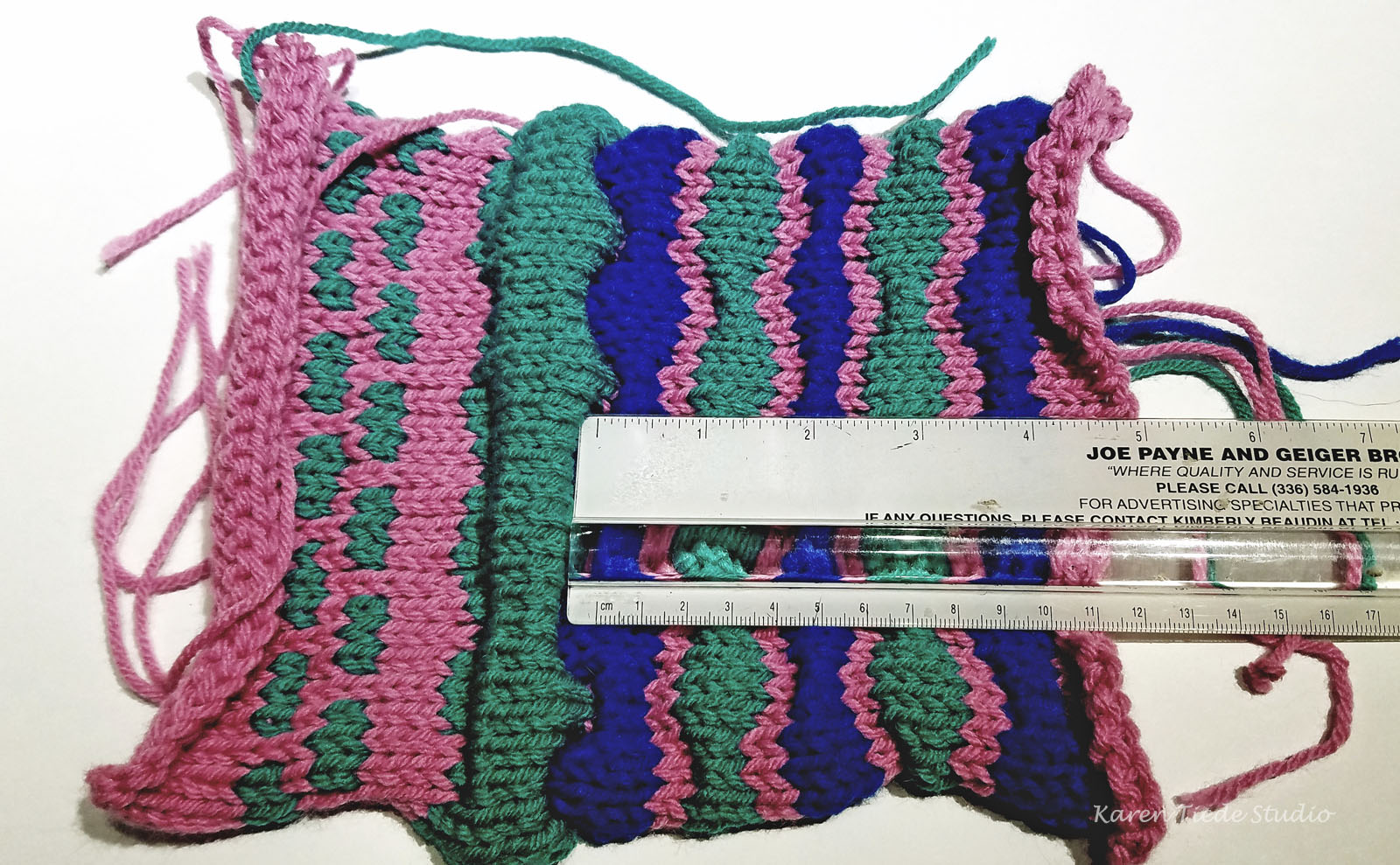
30 rows = 4.25”. This is an afghan; I don’t care about the size except I want it big, so I decided to ignore the 0.25”.
The Yarnspirations website tells me there are 364 yards per skein (in Red Heart, and if this yarn is not marketed as Red Heart it is nevertheless the same size) and I have seven skeins, for a total of 2500 yards. Ravelry tells me I can knit a very big afghan with 2000+ yards, so I’m going for at least 50 x 60”.
60”/4” = 15 units of 30 rows, for 450 rows along the length of the afghan.
450 rows / 7 skeins = 64 rows per skein.
- 3 purple x 64 rows = 192 rows in purple
- 2 blue x 64 rows = 128 rows in blue
- 1 yellow x 64 rows = 64 rows in yellow
- 1 green x 64 rows = 64 rows in green.
Each stripe is a unit of 4 rows purple and 6 rows of a color, for 10 rows. The picture in the book shows a single row of color contrast between the lifted stripes, but that moves the ends of the accent color from COR to COL (for hand knitters, this is from the left to the right side of the work). (Now that I think about it, I can move the carriage to start from either end, so I could use an odd number of rows and not have to cut the yarn to start the next row. I will remember this for the next item I make with this technique—thinking about a Halloween shawl and a single black stripe would make pumpkin shapes.)
450 total rows = 45 stripes.
- 45 stripes, using 4 rows of purple in each stripe, will use 180 rows of purple, nearly the 192 allocated.
- 45 stripes allocated into a 2:1:1 ratio means I need two blue stripes for pair of yellow and green stripes. 22 blue + 11 yellow + 11 green gets pretty close.
- 22 stripes X 6 rows / stripe = 132, which is close.
- 11 stripes x 6 rows / stripe = 66, which is close enough.
Therefore, the repeat pattern is
- Blue
- Yellow
- Green
- Blue
- Blue
- Yellow
- Green
- Blue
So that the two rows of blue together in the middle of the pattern don’t look wrong, I’ll start with two rows of blue and hope to end with two at the other side.
Interestingly, the swatch is not curling at the sides, only at the top and bottom. It may be that top and bottom ribbing will solve the curl problem on two sides of the finished product, and a simple row of crochet along the long edges will dress up the yarn carries along the side.
